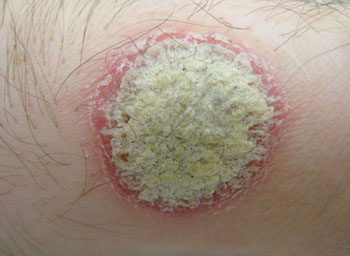Proteins Likely to Trigger Psoriasis Identified
By LabMedica International staff writers
Posted on 04 Feb 2015
Psoriasis is an autoimmune skin disease characterized by well-demarcated areas of red, raised and scaly skin next to areas of normal-appearing skin and is an autoimmune disease where the body launches an abnormal immune response against its own tissues. Posted on 04 Feb 2015
Patients with a genetically susceptible background, some initiating stimulus, often a stressful event, an injury to the skin, or an infection, leads to a coordinated series of signaling events involving cytokines, resident skin cells, and skin-infiltrating immune cells, that once started, initiates a vicious pro-inflammatory hyperproliferative cycle.

Image: A psoriatic plaque, showing a silvery center surrounded by a reddened border (Photo courtesy of Dr. James Heilman).
Scientists at Case Western Reserve University (Cleveland, OH, USA) initially used a mouse model to identify proteins that are important in human psoriasis. They studied seven individuals with chronic moderate to severe plaque psoriasis and six healthy controls were recruited, age range 18 to 75 years, with inclusion criteria including the presence of one or more well-demarcated, scaly, erythematous psoriatic plaques not limited to the scalp. Ribonucleic acid (RNA) was isolated from harvested skin and real-time polymerase chain reactions (qRT-PCR) were performed.
Immunohistochemistry was completed on control human skin and psoriasis patients' uninvolved and involved lesional skin using primary antibodies. Control and psoriasis primary human keratinocyte (KC) cultures were established from adult skin and grown to confluence. RNA was isolated with the RNeasy kit (Qiagen; Germantown, MD, USA), and reverse transcribed, and qRT-PCR were performed (Applied Biosystems; Grand Island, NY, USA).
In the skin of the psoriasis mice, investigators first identified increases in stefin A1 (342.4-fold increased; called cystatin A in humans; solute carrier family 25 (slc25a5) (46.2-fold increased); serpinb3b (35.6-fold increased; called serpinB1 in humans) and Kallikrein-6 (KLK6) (4.7-fold increased). The investigators then confirmed the increased presence of the Serpinb3b, KLK6, Stefin A1 and Slc25a5 proteins in human lesional psoriasis skin tissue, and human lesional psoriasis skin cells compared to healthy control skin tissue and skin cells.
Nicole L. Ward, PhD, associate professor of dermatology and lead author, said, “The underlying cause of psoriasis remains unknown, and the specific signals that trigger disease onset are still being investigated. There currently is no cure. We are always looking for novel targets or new insight into disease progression, remission or susceptibility. It's all about the patients. Even though what we are doing at the bench seems focused on mouse, the ultimate goal is to improve patient care and quality of life for patients.” The study was published on January 1, 2015, in the journal Molecular & Cellular Proteomics.
Related Links:
Case Western Reserve University
Qiagen
Applied Biosystems














